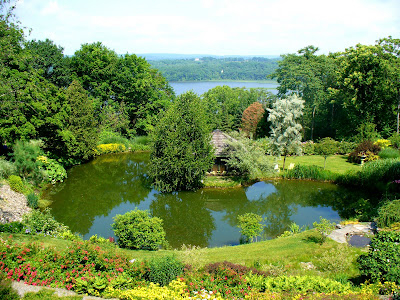- John Gerard 1687

I have been extremely remiss in keeping up with this blog this last month as I have been suffering from a pesky case of vertigo which has still left me walking a bit like a drunken sailor and made close examination of anything (like a computer screen) a bit of a trial. However, i am back with a combined July/August effort extolling the virtues of the vegetable (actually fruit) I have been gorging on these past weeks from the garden.

Eggplants probably had to wage a more considerable uphill battle towards culinary acceptance than any other edible plant, although tomatoes are a close contender. Reputedly originating in India, they are first recorded as being cultivated in China as long ago as 500 BC, although it is entirely possible they were originally grown purely decoratively, as was their solanum cousin the tomato. We know the small, white, egg-shaped variety was perhaps the earliest incarnation of this vegetable, but the Chinese had certainly developed their signature long, thin purple-tinged varieties by the 2nd Century AD, and the Arabs, who had been growing them since at least the 4th century AD, introduced eggplants to Europe in the Middle Ages in that familiar silk/spice road scenario of import and trade typical to cultivars originating in the Far East. However, the eggplant did not really permeate greater Europe until the 16th century and, even then had to twiddle its thumbs around the Mediterranean basin until people managed to surmount the various solanum-related suspicions attached it.

These suspicions find their origins in this controversial fruit's close kinship to deadly nightshade. Accordingly, the eggplant was known across many early cultures as the “mad” or “rage” apple, and, consequently, was thought to induce madness and even death, and as late as 1586, Rembert Doedoens, the Dutch herbalist, claimed they induced “evil humors” and called the eggplant “unwholesome”, as if it could and would influence children’s tender psyches adversely if consumed. Additionally, because eggplants were believed to have originated near the Dead Sea and the imagined site of Sodom & Gomorrah, they were also known popularly, or perhaps unpopularly, as “apples of Sodom”. Josephus, the ancient Jewish historian, wrote that he had himself seen the beautiful purple “apples of Sodom” which, magically and clearly with divine purpose, vanished in smoke when they touched one’s lips. This bit of ancient lore was also employed by John Milton in Paradise Lost, when he spoke of the singularly disappointing diet of the fallen angels. Oddly, this fanciful legend of shining aubergine skin cloaking an interior of bitter ashes may be based in fact. Excavated remains have revealed that, very possibly, it was an invasive insect that begot this particular brand of heavenly magic, boring into the flesh of the eggplant and causing it to powder and decay interiorly while the skin remained beautifully intact. Thus, it would seem it was entirely possible to bite into what appeared to be a glossy bit of heaven only to come up with a mouthful of everlasting repentance.

The eggplant entered Spain in the 12th Century, where four varieties of the controversial plant were grown by the Spanish Moor Ibn-al-awam. The eggplant was then introduced into France by that great gastronome Louis XIV, where it enjoyed fairly wide culinary success, although it seems to have retained some of its “mad” associations and was still listed by Carl Linnaeus as late as 1753 as solanum insanum. Thomas Jefferson is often credited with introducing the eggplant to the Americas, but more likely is its arrival on the southern coast of the Americas via slave ships in the late 16th Century, where it became known as “guinea squash”.

There are countless beautiful varieties of eggplant in a host of wonderful sizes and colorations, from the signature large, stocky shape to the long, thin Oriental types to eggplants like "Fairy Tale" and "Turkish Orange" that are as tiny and winsome as can be imagined. I'm growing four varieties this summer: the gorgeously and voluptuously striated "Listada de Gandia", "Green Long", a light green scimitar of a fruit, "Thai Green" a lovely little striated orb, and "Striped Toga", another little beauty tiger-striped orange and green. As with tomatoes, i view every growing season as an excellent opportunity to trial a new one.

Eggplants are desperate lovers of warm temperatures and grow best in full sun, so wait until nighttime temperatures are consistently above 60 degrees before transplanting outdoors in the spring. Regular watering will help avoid bitter tasting fruit and repeated harvesting will stimulate continuous fruit production. At harvest, the skin of an eggplant should be taut and shiny: fruit that has lost its shine and begun to change color (usually from purple to a bronze-y tone) is overripe and most likely bitter. A good rule of thumb is if you press the fruit with your finger and the skin springs back, then the eggplant is ready for picking. My favorite summer recipe came from our friends Melissa and Christopher at www.canalhousecooking.com. if you have not seen their cookbooks, make haste!

RECIPE:
Cut eggplants into slabs no thicker then 3/4". Marinate in lemon juice, good olive oil, and salt. Grill, turning occasionally, until softened and nicely covered with grill marks on all sides. Return them to the marinade, adding more olive oil, lemon juice and salt, plus a good handful of fresh mint, and a couple of tablespoons of red pepper flakes. Stir to combine and serve.











